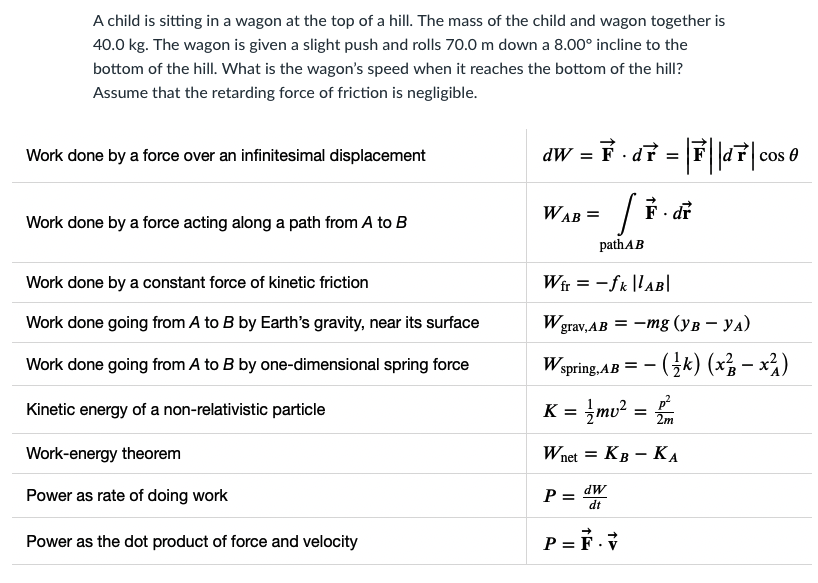A child is sitting in a wagon at the top of a hill. The mass of the child and wagon together is 40.0 kg. The wagon is given a slight push and rolls 70.0 m down a 8.00° incline to the bottom of the hill. What is the wagon's speed when it reaches the bottom of the hill? Assume that the retarding force of friction is negligible.
A child is sitting in a wagon at the top of a hill. The mass of the child and wagon together is 40.0 kg. The wagon is given a slight push and rolls 70.0 m down a 8.00° incline to the bottom of the hill. What is the wagon's speed when it reaches the bottom of the hill? Assume that the retarding force of friction is negligible.
College Physics
10th Edition
ISBN:9781285737027
Author:Raymond A. Serway, Chris Vuille
Publisher:Raymond A. Serway, Chris Vuille
Chapter5: Energy
Section: Chapter Questions
Problem 92AP: Two blocks, A and B (with mass 50.0 kg and 1.00 102 kg, respectively), are connected by a string,...
Related questions
Question

Transcribed Image Text:A child is sitting in a wagon at the top of a hill. The mass of the child and wagon together is
40.0 kg. The wagon is given a slight push and rolls 70.0 m down a 8.00° incline to the
bottom of the hill. What is the wagon's speed when it reaches the bottom of the hill?
Assume that the retarding force of friction is negligible.
dW = F - df = F||d7|
Work done by a force over an infinitesimal displacement
cos 0
%3D
/ F. di
WAB =
Work done by a force acting along a path from A to B
pathAB
Work done by a constant force of kinetic friction
Wir = -fk |lAB|
Work done going from A to B by Earth's gravity, near its surface
Wgrav, AB = -mg (yB – YA)
Work done going from A to B by one-dimensional spring force
Wspring. AB = - (k) (x² – x²)
= }mv² =
p?
2m
Kinetic energy of a non-relativistic particle
K =
Work-energy theorem
Wnet = KB – KA
dW
Power as rate of doing work
P :
dt
Power as the dot product of force and velocity
P = F.V
Expert Solution
This question has been solved!
Explore an expertly crafted, step-by-step solution for a thorough understanding of key concepts.
This is a popular solution!
Trending now
This is a popular solution!
Step by step
Solved in 3 steps

Knowledge Booster
Learn more about
Need a deep-dive on the concept behind this application? Look no further. Learn more about this topic, physics and related others by exploring similar questions and additional content below.Recommended textbooks for you

College Physics
Physics
ISBN:
9781285737027
Author:
Raymond A. Serway, Chris Vuille
Publisher:
Cengage Learning

Principles of Physics: A Calculus-Based Text
Physics
ISBN:
9781133104261
Author:
Raymond A. Serway, John W. Jewett
Publisher:
Cengage Learning

College Physics
Physics
ISBN:
9781305952300
Author:
Raymond A. Serway, Chris Vuille
Publisher:
Cengage Learning

College Physics
Physics
ISBN:
9781285737027
Author:
Raymond A. Serway, Chris Vuille
Publisher:
Cengage Learning

Principles of Physics: A Calculus-Based Text
Physics
ISBN:
9781133104261
Author:
Raymond A. Serway, John W. Jewett
Publisher:
Cengage Learning

College Physics
Physics
ISBN:
9781305952300
Author:
Raymond A. Serway, Chris Vuille
Publisher:
Cengage Learning

Physics for Scientists and Engineers, Technology …
Physics
ISBN:
9781305116399
Author:
Raymond A. Serway, John W. Jewett
Publisher:
Cengage Learning

Glencoe Physics: Principles and Problems, Student…
Physics
ISBN:
9780078807213
Author:
Paul W. Zitzewitz
Publisher:
Glencoe/McGraw-Hill

Classical Dynamics of Particles and Systems
Physics
ISBN:
9780534408961
Author:
Stephen T. Thornton, Jerry B. Marion
Publisher:
Cengage Learning